1059 WHAT IS A MOLOSSER
WHAT IS A MOLOSSER?
by David Hancock
Time and time again, in books and magazines, especially on the continent and in North America, the mastiff group of dogs is blurred with the molossers, or dogs claiming ancestry with the huge dogs of the Molossi people. The "gripping" or "holding" breeds like the Bulldog, the Bullmastiff, the Dogue de Bordeaux, the Cane Corso and the Perro de Presa Canario have become "molossers" in spite of any evidence that I can detect. I have searched the literature, art galleries and museums of Greece and Italy without avail. But there is evidence in abundance of big Molossian dogs taking two distinct forms: a flock guardian and a hound of the chase. But who were the Molossi? They were an Epirote people, ascendant from 500 to 300 BC. Their tribal kingdom stretched from north of Mount Pindus to the headwaters of the Thyamis river, on the Greek mainland, opposite Corfu. Other tribes rallied to them in their battles with the Illyrians from the north. The Molossi were Greek-speaking, sheep-owning, mainly mountain dwellers who cultivated valleys, occupying the wettest part of Greece, with heavy snowfalls in winter and many villages above 5,000 feet in altitude. The Molossi came originally in migrations from the north. In 167 BC Molossia was captured by the Romans and a sizeable proportion of its people enslaved. In happier times, two hundred years earlier, the Molossi had issued their own silver coinage with, as its emblem, the Molossian hound, a tribute to its fame.

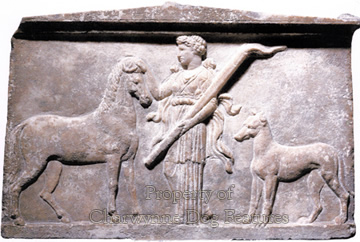
But what do the real experts say about mastiffs and molossers? The great Mastiff breed authority, MB Wynn in his The History of the Mastiff of 1886 wrote: "The term for the mastiff among some naturalists, is the molossus, originating with our early writers, who chose to think that the classic writers meant a mastiff, in the sense we now use the word, whereas the molossus was not in reality a mastiff. Many people therefore erroneously think the word molossus necessarily means a mastiff..." The eminent authority of dogs, Edward C. Ash in his Dogs: their history and development of 1927, stated: "The history of the breed is confusing. Apart from the somewhat unreliable claims of research workers, the numerous references in early works cannot be relied on, as the name molossus, which is usually translated mastiff, was often applied to any large dog." In his History of Animals c.347BC, Aristotle wrote (Revised Oxford translation, ed. Jonathan Barnes, 1984): "Of the Molossian breeds of dogs, such as are employed in the chase are much the same as those elsewhere; but the sheepdogs of this breed are superior to the others in size, and in the courage with which they face the attacks of wild animals." No mention of broad-mouthed gripping dogs there!
But the 'mischief-makers' have been at work too! Markham, in 1616, misquoted Gratius's Cynegeticon with these words: "From a Country of Epirus, call'd antiently Molossia...comes a noble race of Dogs celebrated by all antiquity, and preferr'd before those of any other Nation whatsoever for matchlesse stoutnesse untill Britain being discover'd, and our Dogs brought to tryal. the Molossians were found to be surpassed in courage by the Brittish Mastiffes." But as Jan Libourel, an American professor of ancient history, has pointed out, what Gratius actually wrote was to this effect: "If you want a good hound, a trip to Britain would almost be worth it. The British dogs may not look much, but for bravery in combat even the famous Molossus does not surpass them." The word mastiff was never used in this much misused quote. Jan Libourel also made this comment on the words of the poet Aurelius Olympius Nemesianus c.284 AD: "Nemesianus, then, makes it abundantly clear that the Molossus dog, far from being some sort of mastiff, was actually a rangily built coursing dog, probably more akin to the greyhound." And in his Hunting in the Ancient World of 1985, JK Anderson stated: "...the Molossian breed was coming into increasing favor. Its qualities had, in fact, been noticed in classical Greece, though Xenophon does not mention it. It was derived from the guard dogs employed by the shepherds among the mountains of north-western Greece; 'sheep dogs' would be a misleading term, because the Greek shepherd did not, and does not, use his dogs to herd sheep, but to protect them from wolves and robbers." No link with the Mastiff breed there!
But what does recorded history tell us of the dogs of the Molossi? Aristotle, 384-322 BC, wrote of..."The Molossian breed, moreover, the hunting kind, differs in no way from the rest...But famous above all for courage and hard work is the progeny of Molossian crossed with Laconian". He therefore acknowledges more than one kind and recommends an outcross! But he also recorded that "The Epirote dogs are the largest of all." Varro, born in 116 BC, wrote: "Dogs are called after the district that they come from, as Laconian, Epirot, Sallentine...", going on to differentiate between butchers' dogs and hunting dogs. Theodore Gaza, an eminent Greek scholar of the fifteenth century, refers to "...the Colophonian breed and that of the Castabalienses, who had regiments of dogs that fought in the Van of War", with Pliny as his source. Aelian, living in the early part of the third century AD, wrote that: "The Hyrcani and Magnesii used to be accompanied into battle by their dogs". Neither of these authorities wrote of the Molossian dog as a war-dog.
In his The Golden Age of Persia of 1975, Richard Frye writes: "One should not fail to mention Gurgan (Arabic: al-Jurjan), ancient Hyrcania, a fertile province to the east of the Caspian Sea, where from ancient times settled Iranians had to defend their lands against nomads from the northern steppes." Inevitably this was where valuable goods, including hounds and horses, were traded between the plain dwellers in settlements and the nomadic tribes from the north and north-east. Hyrcania embraced mountainous forests, extensive plains, lakes and rivers, with wild life ranging from tigers, bear, hyenas, wolves and wild boar to wild horses, asses, buffalo, deer and antelope. These animals were the traditional quarry for hunting mastiffs and holding dogs. Mallory mentions that pottery of the 'grey ware' tradition had appeared in Gorgan before the end of the fourth millennium (i.e. 3,000 BC) and by "migration or diffusion" had been discovered as having been in use in western Iran, towards the Zagros mountains, two thousand years later. He states: "In the south-east Caspian, the culture that emerges in the Iron Age, the Dahistan culture, is solidly regarded as Iranian (the land designated Varkana (Hyrcania) in early Iranian texts), and it is seen to have emerged out of the local Gorgan tradition possibly coupled with steppe influences." The movement south-westwards of steppe nomads spanned several millennia; wherever they went horses and hunting dogs went too.
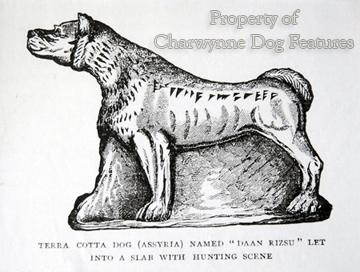

The well-known "terra-cotta dog" of Asshurbanipal would be a fair representative of the prototypal mastiff family. Several ofthese statuettes have been found, bearing such names as "Tear the Foe" on the back of the collars. As already discussed, there are also canine artefacts from even older periods e.g. Lagash and Larsa. The first Lagash dynasty was from around 2500-2350BC; the Larsa people were ascendant in the early second millennium BC, i.e. four thousand years ago. In his much respected work 'The Sumerians, their History, Culture and Character' (University of Chicago Press, 1963) Samuel Noah Kramer records how "animal husbandry was supplemented by hunting, and there are texts recording the deliveries of deer, wild boars and gazelles." He also mentions accounts of 'successful hunting on the plain'. The Sumerian artefacts of broad-mouthed dogs, one of a bitch suckling four pups and the other of an alert lying dog could well be portrayals of mastiff breeds today. Why should the broad-mouthed breeds be robbed of two thousand years of their history by scholars who know little of dogs? The famous Assyrian bas-relief in the British Museum shows with remarkable vividness the use of heavy hounds to hunt wild asses. More recently the paintings of artists such as Hondius, Snyders and Hackert, together with the drawings and etchings of Ridinger, have depicted very distinctly the heavy hounds used at the kill in European hunting scenes. These huge strapping dogs were utilised all over Europe in the Middle Ages and subsequently. The holding and gripping or pinning breeds, collectively known as the broad-mouthed dogs, recklessly brave and renowned for their ferocity, were quite invaluable, especially before the development of firearms.

The Sumerians settled in Mesopotamia in the fifth millennium BC and thrived until the early second millennium BC; interestingly their language resembled the Mongol speech, being reminiscent of the Ural-Altaic languages. Their early rulers maintained close ties with the city-state known as Attala, believed to have been located in the region of the Caspian Sea. Artefacts depicting broad-mouthed dogs have been found at Lagash (now Shippurla) and Larsa (biblical Ellasar, now Senkerah) and dated at two thousand BC. Only in the twentieth century did scholars discover the importance of Sumer as an advanced civilisation; it may well be that the Sumerians migrated south-west from Tartary taking their huge hunting mastiffs with them. Certainly their artefacts of mastiff-like dogs are the oldest ever found. In this part of the world, Persia was a central Asian power, the link between east and west. The Babylonians were hunting with broad-mouthed hounds two thousand years before the Molossi were even known. The Assyrians were hunting with broad-mouthed hounds one thousand years before the Molossi were known.
Despite this scholars with no knowledge of dogs still attribute the origin of the mastiff group to a small isolated group of mountain people in Epirus, rightly famous for a different type of dog. Scholars translating Gaza, Gratius, Varro and Aristotle, especially in the Middle Ages when the word mastiff meant any and every huge hefty dog, are the source of much misinformation. They have misled any number of breed researchers who read the word mastiff as synonymous with the name of the modern pedigree breed.
Take for example this quote:
"When half enraged,
The rude Molossian mastiff, her keen teeth
Baring tremendous,"
Such a quotation is so often used, or rather misused, by mastiff devotees to prove a point on the breed's heritage. But if you look at the Latin original:
"Inritata canum quom primum magna Molossum
Mollia ricta fremunt, duros nudantia denteis,"
you can quickly see that the word mastiff is missing. Once scholars started perpetuating the idea that a huge fierce dog from Molossia is a mastiff, their subsequent words fed the tendentious researches of breed historians. In his The History of the Mastiff of 1886, even Wynn gave the view that: "Many people therefore erroneously think the word molossus necessarily means a mastiff, whereas the Greeks only became acquainted with the true mastiff about the time of the Macedonian conquest at 336 BC."
.jpg)

Similar misapprehensions have led Tibetan Mastiff fanciers to misapply the records of Marco Polo's travels. He allegedly referred to "mastiffs as large as donkeys" but didn't use the word mastiff at all. His translators, scholars with no knowledge of dogs, did so. His record was of huge dogs, the size of local donkeys (smaller than ours) which "...are trained to hunt every type of animal; but particularly the huge and fierce wild oxen. There are many different kinds of hounds..." I would read this as meaning that hounds of the chase were variously employed to seize and pull down big game. This part of the world, in those times, came under Kubla Khan. We also learn from Marco Polo that from October to March the court was provided with 1000 head of game per day. Two thousand men in red and another two thousand in blue, each colour supported by as many as 5,000 dogs, hunted in two lines spread out over a distance of a day's journey. The hounds walked, the hunters were mounted. Translators have referred to these dogs as mastiffs when they should have called them heavy hounds. Does anyone seriously think that the Mastiff breed of today so often linked by their owners with the Marco Polo reference could carry out such a feat? Many that I see in the show ring can scarcely manage a circuit or two. Yet Mastiff breed researchers regularly claim links with such hounds entirely because the ignorant translators have misused the word mastiff.
Because steppe nomads long before the Great Khan, the Scythians and the Sarmatians, were illiterate and left little trace of their arts and crafts, we have tended to underrate their astonishing impact on other civilizations. Their mastery of the horse brought them over the Caucasus and Carpathians to provide cavalry for the Greeks and Romans and teach the Assyrians most of what they knew about the use of the horse. On their belt buckles and shields the elongated "S" denoted the dog. Before about 1500 BC Egyptian hunters operated on foot but then the Hyksos arrived from the southern steppes with horse and chariot. From then on Egyptian noblemen had stables as well as kennels. The steppe nomads also had hounds with the capability of keeping up with the horses. So these were traded too. The Alans, probably the mightiest tribe of the Sarmatians at one period and famous horsemen, accompanied by huge hounds, reached well into Western Europe in their time. They also provided the cavalry for Roman legions in northern Europe. Topographical place names of Alanic origin appear in Poland, Slovakia, Serbia, Croatia, Germany, Georgia, France (e.g. Alencon), Spain and throughout the Roman Empire, including Britain.
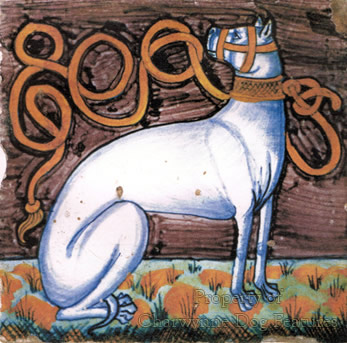

"Another mediaeval hound frequently mentioned was the alan or alaunt. It is, quite probably, a near relative of the modern Great Dane or German Boarhound. Resemblance to the last named species is indicated by what Master of Game says of their shape and coloration. It was a powerful, aggressive beast, and held 'faster of his biting than can three greyhounds the best any man can find.' Their chief role was played in boar-hunting, always a sanguinary sport and most destructive to a good pack. When the boar took refuge in a thick wood, and running hounds were unable to make him come out, alaunts were loosed and 'if they be slain by the wild boar...it is not very great loss." So wrote Henry L Savage, in his Hunting in the Middle Ages published in Speculum (Vol 8, parts 30-41) in 1933. He may have been unaware of the wide range of holding dogs embraced by the word alaunt.
No depiction of an Alaunt shows an over-boned cloddy heavily-built short-faced yard-dog. They show, not the American Bulldog conformation, but much more apparently the Rhodesian Ridgeback/Dogo Argentino style: just over two feet high, with tuck-up, strong-headed with breadth right down to the nose, but never a Bulldog head, a powerfully muscled body, short-haired and with small drop ears, essentially a real canine athlete. Such a dog had to be able to clear obstacles, keep up with the mounted hunters and pull down its quarry, usually boar or stag. Eventually, as the par force hunt developed into less of a steeplechase, the seizers were held by their collars until needed, and referred to as bandogges. But for all their power in the charge, such dogs had to accompany the hunt, which demanded stamina, and clear fallen logs or undergrowth at speed, which demanded explosive power. One day the kennel clubs of the world will accept that mastiffs were heavy hounds; even the international body, the FCI, groups them as 'Molossers and Dogues', embracing mountain dogs and the mastiff breeds. The recognition of breeds and the subsequent alteration of them by show ring fanciers has led the general public to assume that the Bulldog was always squat, muzzle-less and unathletic and the Mastiff huge, bulky and unathletic; not so. The Mastiff's true ancestors were heavy hounds not mountain dogs; the Bulldog's real ancestors were alauntes of the butcheries not pug-mastiffs.
Because the Molossian hound and the Molossian flock-guarding dog were fierce and at times savage (as Aristotle records) they were lumped together with the other "canes pugnaces or bellicosi". Statius wrote of the soldiers of the Molossi weeping over their faithful canine companions slain in the war. But the Molossi used their huge dogs as outpost sentries not as war-dogs, as the Hyrcani did. Even in the last century, the Suliot dog (from the Suli mountains in Epirus) was used to guard outposts in the war between the Austrians and the Turks (the latter using dogs too, much like today's Anatolian Shepherd Dog). These huge dogs found their way into Western Europe (Lord Truro owning one) and a role as 'parade dogs', marching as mascots at the head of regiments. They were subsequently bred with German boarhounds. No dog writer of those times suggested that these dogs were modified brachycephalic or broad-mouthed dogs. It is highly significant that the Romans referred to the latter as Canes Pugnaces or Bellicosi and not Molossi.


The French professor Pierre Megnin, in 1896, a trifle simplistically, defined four basic canine skull structures: lupoides (e.g. the spitz breeds with the long muzzle), braccoides (e.g. the scent-hound family), graioides (e.g. the sight-hound family) and molossoides (e.g. the mountain dogs, 'fighting dogs', mastiff breeds and even Pugs), and listed the breeds of dog identified then either in these groups or from a mixture of them. At that time Megnin was unaware of the Sumerian hounds or the pre-dynastic dogs of Hierakonpolis, but clearly knew of the Molossi and their dogs, if not their hounds. Felice Cesarino believes that some of the Saharan graffiti showing heavy-skulled dogs could be from the "grande fauna selvaggia" phase, ante-dating the Sumerians. Johan Gallant, President of the Africanis Society in South Africa, who pointed this out to me, shares my belief that an update of Megnin's classification is long overdue.
Blaine, writing in his Encyclopaedia of Rural Sports of 1840, makes a number of points for me when he states that: "Linnaeus appears to have erred much in naming this variety (i.e. the Bulldog) Molossus...Much of the obscurity which attends the origin of the Bulldog has arisen from confounding him with the ancient account of other pugnacious dogs..." He then goes on to make rude remarks about the ignorance of translators "who could not distinguish a Bulldog from a cur". Wynn, writing forty years later, stated that: "Classical writers carelessly or for convenience called any and all dogs approaching anything like the dogs of Epirus in size or character by the common term molossus...classical writers used the word molossians at a later period to embrace the true mastiff and allied groups, and Dr Caius, Gesner, Linnaeus, and other naturalists followed the classical jumble. Therefore readers and translators should be very guarded how they render molossus as a mastiff, for the true molossian was...identical or almost so, with the modern Suliot boarhound." Scholars and natural historians have I believe compounded their own errors over many, many years.
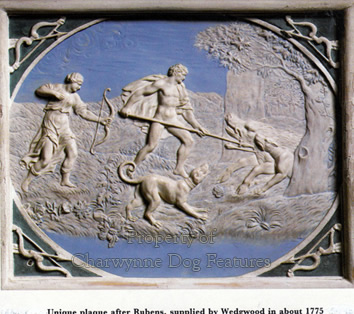
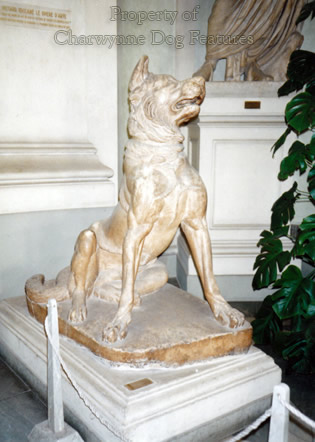
A description of a Molossian dog is contained in Travels in Sicily, Greece and Albania by the Rev. Thomas Smart Hughes, of 1820: "The colour of these dogs varies through different shades from a dark brown to a bright dun, their long fur being very soft and thick and glossy; in size they are about equal to an English mastiff; they have a long nose, delicate ears finely pointed, magnificent tail, legs of moderate length, with a body nicely rounded and compact." It is significant that although the Rev. Hughes evidently knew what an English Mastiff looked like, he did not suggest, size apart, that there were any other similarities. The statue of a Molossian dog in the Uffizi Gallery in Florence does not portray a broad-mouthed dog. The Molossian dog took two forms: a big flock-guarding breed, rather like the Anatolian Shepherd Dog (used widely in the Ottoman Balkans), the Greek Sheepdog, the Sarplanninac of Macedonia and the Karst of Slovenia, and a huge hound, perhaps perpetuated today by breeds such as the Great Dane and the Rhodesian Ridgeback. In Dr Smith's Classical Dictionary of 1859, he writes "The Mollossian hounds were celebrated in antiquity, and were much prized for hunting." Martial describes a venatio in Rome at which a hind is chased by swift Molossians. Claudian refers to the Molossian dogs guiding the huntsman to his prey by their subtle scent. The mastiff group, the strong-headed, broad-mouthed breeds such as the Perro de Presa Canario, the Neapolitan Mastiff and the Dogue de Bordeaux have a quite separate Central Asian origin.


 - featuring a Molossian Hound.jpg)
Once breeders either ignore their breed's origin or get misled by false research (or ignorant translators!), then essential breed-type is threatened. The Germans call the Great Dane, Deutsche Dogge, or German Mastiff; the consequence must not be square-headed, lower-slung dogs with all their weight on the forehand. Breed titles and breed histories are all too often misleading and they do matter. Undoubtedly the true mastiff breeds and the flock guarding breeds have been interbred in the past for a variety of reasons. I suspect that any modified brachycephalic breed that is over 28" at the shoulder has been the recipient of blood from a flock-guarding breed. The phenotype of the true mastiff breeds is 24-28" so that size and especially bulk does not conflict with function. The requirements in a heavy hound and in a flock-guarding breed are essentially different and that difference really does matter. Loose groupings like Molossers are fine - as long as they refer to hounds of the chase or the huge flock guardians and not the seizing and holding or 'gripping' breeds. The Molossi bred magnificent huge dogs, but they were not mastiffs.


.jpg)

